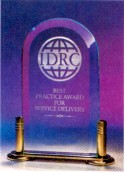 “Even if you’re on the right track, you’ll get run over if you just sit there,” humorist Will Rogers once observed.
“Even if you’re on the right track, you’ll get run over if you just sit there,” humorist Will Rogers once observed.
That says a lot about leadership, an eternally discussed but skimpily understood business success factor. When it comes to real estate leadership, though, a case study is at hand: the alliance between UnitedHealth Group Real Estate Services (CRES), Trammell Crow Outsourcing Services (TCOS), Steelcase and RSP Architects. That group’s tight teamwork was honored as a 1999 Best Practices Award winner in Leadership by the International Development Research Council (IDRC), the world’s preeminent corporate real estate (CRE) association.
You don’t have to be Wittgenstein to understand why. After 1996’s United HealthCare/MetraHealth merger, leadership was sorely needed, particularly in real estate.
In the merger’s wake, Minneapolis-based UnitedHealth (www.unitedhealthgroup.com) had 378 locations, 30,000 employees and a CRE staff of 60-plus, largely split between Minneapolis and Hartford, Conn.
Moreover, the post-merger scenario encompassed many CRE pros’ worst nightmares: duplicate facilities, fragmented service delivery, varying workstation sizes and quality, inconsistent design, divergent “infostructures,” and, perhaps most significantly, precious little centralized CRE data.
“It’s not possible to manage what’s not measured,” contends Tom O’Connor, UnitedHealth CRES vice president.
Assembling the Team
CRES’s measured efforts began by selling UnitedHealth management on the value of centralizing CRE functions, abandoning local field offices’ management.
CRES also began forming key long-term strategic alliances with what O’Connor calls “best-of-class service providers”: TCOS for project/facilities management; Steelcase’s Furniture Management Coalition for furniture asset management; and RSP Architects for design.
“True collaborative partnering” was what O’Connor wanted, with everyone, in or out of house, empowered to challenge anything.
Soon, there was a lot to challenge, as the alliance began establishing extensive real estate metrics and delivery models.
Big Bottom-Line Benefits
Leadership questions evoke another American adage that Will Rogers didn’t author: Money talks and . . . other stuff walks.
And after three years, the CRES alliance has the hard numbers to clearly demonstrate value-added management.
In facilities management, for example, it’s attained overall fees for a 3.5 million-sq.-ft. (315,000-sq.-m.) portfolio that are 30 percent below industry standards; and it’s reduced both operating costs and vendor costs by 8 percent.
In project management, CRES reaped a major payoff in it decision to retain its partners on what O’Connor calls “a variable cost basis.” That flexibility has facilitated CRES’ being able to both manage 90 projects simultaneously and to adjust its workload by 50 percent without service or quality disruptions.
In furniture asset management, the alliance’s culling and consolidation saved $5.6 million, while asset reuse saved $2.7 million. The team also slashed UnitedHealth’s 36 business unit-managed furniture warehouses to six centrally managed regional facilities.
In addition, the four-pronged partnership standardized workstations; and it developed national design standards and a national design-fee matrix 15 percent below market rates.
Smashing the Silos
Reflecting IDRC’s leadership in Corporate Infrastructure ResourceSM (CIR) management, the alliance also pulled together important related functions that were operating as virtual silos. CRE, for example, had trouble even ascertaining basic facility-specific information like total employment or real estate-related expenditures, O’Connor says.
To fix that fragmentation, CRES established relationships with human resources (HR), information technology (IT) and procurement as “internal peer departments.”
Consequently, CRES and HR now collaborate, enabling informed top management decisions about people, places and strategy.
Likewise, coordinating with procurement produced $25.6 million in savings. (In fact, the model’s effectiveness prompted a CRES/procurement merger.) And the IS partnership produced uniform company-wide cabling that has enhanced flexibility and cuts costs.
All in all, a pretty staggering accomplishment. And one that’s made CRES an integral part of senior management’s planning. In fact, CRES is leading a multi-disciplinary group in developing the company’s “Anywhere Work” program.
And CRES accomplished all this as it reduced its in-house staff to only nine members over a three-year span.
As for the future, O’Connor notes, “We’re changing our focus from efficiency to effectiveness. But though we’ve successfully steered through some very turbulent waters, inevitably they’ll rise again. But we’re well positioned to navigate what’s ahead and continue to steer toward success.”

— Jack Lyne
